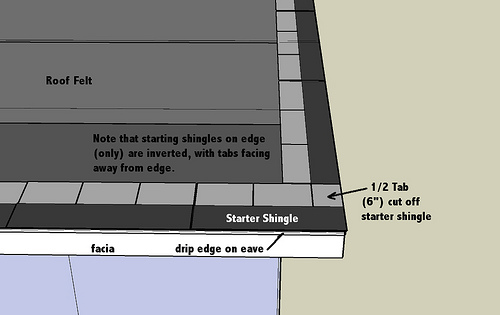The first thing to know is that if you order shingles based solely on the Squares or Square foot area of the roof, you won’t have enough. You will need shingles for starter courses along the eaves and at some rakes, and you will need shingles to cap hips and ridges. You can cut shingles to use as these caps, ridges and starter, as well as cutting at the rakes, against walls and chimneys, and at valleys. This cutting will always cause some waste. Some of the cutoffs will be big enough to use as starter shingles or in other areas where cut shingles are needed, but smaller cutoffs will be waste. Waste can vary from 10-15% depending on the complexity of the roof.
- The only roof that will generate no waste from cutting is a simple gable roof whose length is divisible by the 3-ft. length of a shingle.
You need to know a few things before you start calculating materials like the pitch of the roof as well as the dimensions. Then you can do your material calculations. See the pitch calculation chart at the bottom of this page to factor pitch into the equation of calculating roof size.
What is the slope or pitch of a roof?
The slope/pitch of the roof is the incline of the roof expressed as a ratio of the vertical rise to the horizontal run. This ratio is expressed as inches per foot. So a a roof that rises 4 inches in 1 foot or in 12 inches is called a 4/12 pitch or slope. If you do not have the correct pitch/slope you will not be able to get the correct size of your roof. See the pitch calculator below or click here.
Parts of a shingle roof

Starter Shingle – is the shingle at the ‘bottom edge’ of the roof with the exposure portion trimmed off, leaving just the self-seal strip and top lap. They are fastened along the eaves edges to seal down the first course of shingles and provide coverage material beneath the tab cutouts just like the top lap of each successive course.
Drip Edge
- Linear feet/10 + 5 = Drip Edge Needed (1 1/2 x 1 1/2)
Starter – calculate starter from the parameter measurement
- Parameter Linear Feet/120 = # of Bundles of Starter for 20 year
- Parameter Linear Feet/80= # of Bundles of Starter for 30 year
Ridge – there are various types, some cut from 20 or 25 year shingles (standard ridge) or high profile ridge which provides stronger ridges that are further resistant to damage, stand slightly higher and look nice on your roof cap lines. However in most cases regular shingles are cut to be used as ridge.
- High Profile Ridge is usually 20LF per box, but varies by manufacturer
- Standard Ridge (cut shingles) can cap 35 lin. ft. of ridges and hips with each bundle of shingles.
Calculating Ridge
- Hip + Ridge = Ridge Needed
- Linear Feet/33 = # of bundles needed for ridge
*Ridge Vent use 9in for 30 year shingles which will require separate nails, not the coil nails.
Valley
- Linear feet/33 = # of rolls needed
Felt
- Number of Squares/4 = # of rolls of 15# felt needed
- Number of Squares/2 = # of rolls of 30# felt needed
- Number of Squares/10 = # of rolls of synthetic felt needed
Nails
- 1 box per 20-25 squares
Step Flashing
- include at least 1 box per job if there is a chimney
Calculation for proper roof area
If the home measures 20 X 40 and has a 7:12 roof, then to calculate the slope of the roof follow these steps:
Step 1: Multiply 20 and 40 which equals 800.
Step 2: Find the value of 7:12 from the roof slope multiplier table which is 1.16.
Step 3: Multiply Step 1 and Step 2, i.e. 800 multiplied by 1.16.
Step 4: The value arrived at, 928, reflects the square feet of the roof.
Example calculation:
Roof is 8/12 pitch and measures at 1900 square feet
1900 x 1.2= 2280
2280 – 1900= 380 feet added for pitch
| Roof Pitch | Roof Pitch Multiplier |
| 2/12 | 1.01 |
| 3/12 | 1.03 |
| 4/12 | 1.05 |
| 5/12 | 1.08 |
| 6/12 | 1.12 |
| 7/12 | 1.16 |
| 8/12 | 1.20 |
| 9/12 | 1.25 |
| 10/12 | 1.30 |
| 11/12 | 1.35 |
| 12/12 | 1.41 |
| 14/12 | 1.54 |
| 16/12 | 1.67 |
| 18/12 | 1.80 |
| 20/12 | 1.94 |
| 22/12 | 2.09 |
| 24/12 | 2.24 |




No responses yet